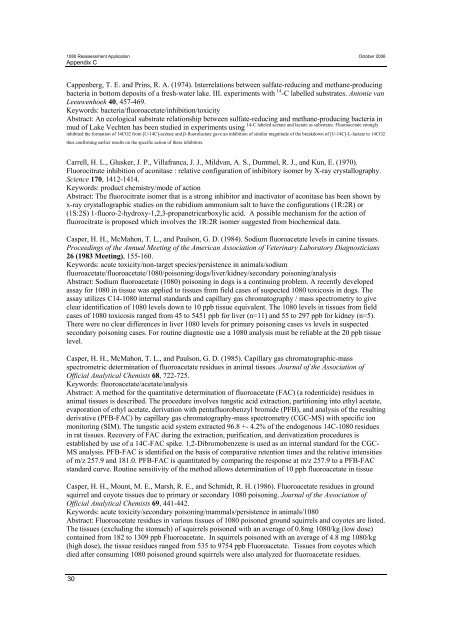Source: Landcare Research (1964). Control of poisons. Royal ...
Source: Landcare Research (1964). Control of poisons. Royal ...
Source: Landcare Research (1964). Control of poisons. Royal ...
You also want an ePaper? Increase the reach of your titles
YUMPU automatically turns print PDFs into web optimized ePapers that Google loves.
1080 Reassessment Application October 2006<br />
Appendix C<br />
Cappenberg, T. E. and Prins, R. A. (1974). Interrelations between sulfate-reducing and methane-producing<br />
bacteria in bottom deposits <strong>of</strong> a fresh-water lake. III. experiments with 14 -C labelled substrates. Antonie van<br />
Leeuwenhoek 40, 457-469.<br />
Keywords: bacteria/fluoroacetate/inhibition/toxicity<br />
Abstract: An ecological substrate relationship between sulfate-reducing and methane-producing bacteria in<br />
14-C labeled acetate and lactate as substrates. Fluoroacetate strongly<br />
mud <strong>of</strong> Lake Vechten has been studied in experiments using<br />
inhibited the formation <strong>of</strong> 14CO2 from [U-14C]-acetate and β-fluorolactate gave an inhibition <strong>of</strong> similar magnitude <strong>of</strong> the breakdown <strong>of</strong> [U-14C]-L-lactate to 14CO2<br />
thus confirming earlier results on the specific action <strong>of</strong> these inhibitors.<br />
Carrell, H. L., Glusker, J. P., Villafranca, J. J., Mildvan, A. S., Dummel, R. J., and Kun, E. (1970).<br />
Fluorocitrate inhibition <strong>of</strong> aconitase : relative configuration <strong>of</strong> inhibitory isomer by X-ray crystallography.<br />
Science 170, 1412-1414.<br />
Keywords: product chemistry/mode <strong>of</strong> action<br />
Abstract: The fluorocitrate isomer that is a strong inhibitor and inactivator <strong>of</strong> aconitase has been shown by<br />
x-ray crystallographic studies on the rubidium ammonium salt to have the configurations (1R:2R) or<br />
(1S:2S) 1-fluoro-2-hydroxy-1,2,3-propanetricarboxylic acid. A possible mechanism for the action <strong>of</strong><br />
fluorocitrate is proposed which involves the 1R:2R isomer suggested from biochemical data.<br />
Casper, H. H., McMahon, T. L., and Paulson, G. D. (1984). Sodium fluoroacetate levels in canine tissues.<br />
Proceedings <strong>of</strong> the Annual Meeting <strong>of</strong> the American Association <strong>of</strong> Veterinary Laboratory Diagnosticians<br />
26 (1983 Meeting), 155-160.<br />
Keywords: acute toxicity/non-target species/persistence in animals/sodium<br />
fluoroacetate/fluoroacetate/1080/poisoning/dogs/liver/kidney/secondary poisoning/analysis<br />
Abstract: Sodium fluoroacetate (1080) poisoning in dogs is a continuing problem. A recently developed<br />
assay for 1080 in tissue was applied to tissues from field cases <strong>of</strong> suspected 1080 toxicosis in dogs. The<br />
assay utilizes C14-1080 internal standards and capillary gas chromatography / mass spectrometry to give<br />
clear identification <strong>of</strong> 1080 levels down to 10 ppb tissue equivalent. The 1080 levels in tissues from field<br />
cases <strong>of</strong> 1080 toxicosis ranged from 45 to 5451 ppb for liver (n=11) and 55 to 297 ppb for kidney (n=5).<br />
There were no clear differences in liver 1080 levels for primary poisoning cases vs levels in suspected<br />
secondary poisoning cases. For routine diagnostic use a 1080 analysis must be reliable at the 20 ppb tissue<br />
level.<br />
Casper, H. H., McMahon, T. L., and Paulson, G. D. (1985). Capillary gas chromatographic-mass<br />
spectrometric determination <strong>of</strong> fluoroacetate residues in animal tissues. Journal <strong>of</strong> the Association <strong>of</strong><br />
Official Analytical Chemists 68, 722-725.<br />
Keywords: fluoroacetate/acetate/analysis<br />
Abstract: A method for the quantitative determination <strong>of</strong> fluoroacetate (FAC) (a rodenticide) residues in<br />
animal tissues is described. The procedure involves tungstic acid extraction, partitioning into ethyl acetate,<br />
evaporation <strong>of</strong> ethyl acetate, derivation with pentafluorobenzyl bromide (PFB), and analysis <strong>of</strong> the resulting<br />
derivative (PFB-FAC) by capillary gas chromatography-mass spectrometry (CGC-MS) with specific ion<br />
monitoring (SIM). The tungstic acid system extracted 96.8 +- 4.2% <strong>of</strong> the endogenous 14C-1080 residues<br />
in rat tissues. Recovery <strong>of</strong> FAC during the extraction, purification, and derivatization procedures is<br />
established by use <strong>of</strong> a 14C-FAC spike. 1,2-Dibromobenzene is used as an internal standard for the CGC-<br />
MS analysis. PFB-FAC is identified on the basis <strong>of</strong> comparative retention times and the relative intensities<br />
<strong>of</strong> m/z 257.9 and 181.0. PFB-FAC is quantitated by comparing the response at m/z 257.9 to a PFB-FAC<br />
standard curve. Routine sensitivity <strong>of</strong> the method allows determination <strong>of</strong> 10 ppb fluoroacetate in tissue<br />
Casper, H. H., Mount, M. E., Marsh, R. E., and Schmidt, R. H. (1986). Fluoroacetate residues in ground<br />
squirrel and coyote tissues due to primary or secondary 1080 poisoning. Journal <strong>of</strong> the Association <strong>of</strong><br />
Official Analytical Chemists 69, 441-442.<br />
Keywords: acute toxicity/secondary poisoning/mammals/persistence in animals/1080<br />
Abstract: Fluoroacetate residues in various tissues <strong>of</strong> 1080 poisoned ground squirrels and coyotes are listed.<br />
The tissues (excluding the stomach) <strong>of</strong> squirrels poisoned with an average <strong>of</strong> 0.8mg 1080/kg (low dose)<br />
contained from 182 to 1309 ppb Fluoroacetate. In squirrels poisoned with an average <strong>of</strong> 4.8 mg 1080/kg<br />
(high dose), the tissue residues ranged from 535 to 9754 ppb Fluoroacetate. Tissues from coyotes which<br />
died after consuming 1080 poisoned ground squirrels were also analyzed for fluoroacetate residues.<br />
30








![Application for test certificate [pdf, 131kb]](https://img.yumpu.com/50666502/1/184x260/application-for-test-certificate-pdf-131kb.jpg?quality=85)








